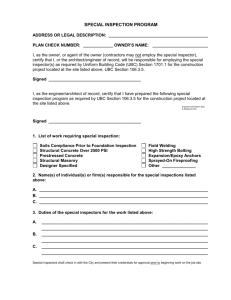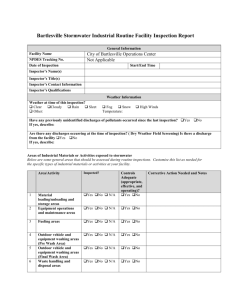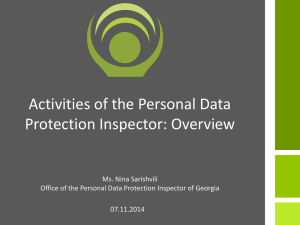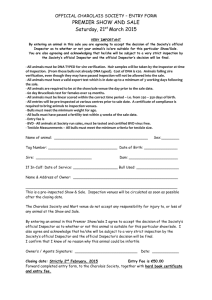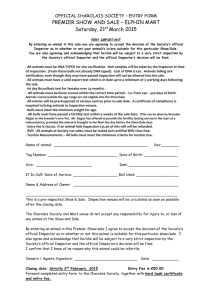Alabama Standards of Practice
advertisement
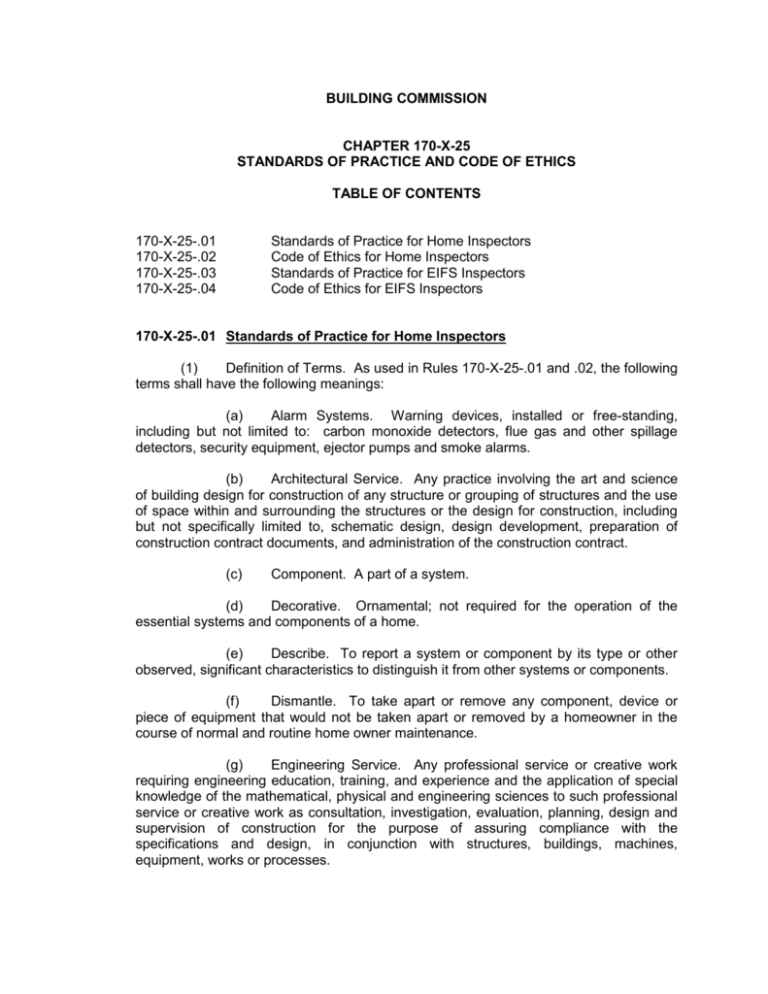
BUILDING COMMISSION CHAPTER 170-X-25 STANDARDS OF PRACTICE AND CODE OF ETHICS TABLE OF CONTENTS 170-X-25-.01 170-X-25-.02 170-X-25-.03 170-X-25-.04 Standards of Practice for Home Inspectors Code of Ethics for Home Inspectors Standards of Practice for EIFS Inspectors Code of Ethics for EIFS Inspectors 170-X-25-.01 Standards of Practice for Home Inspectors (1) Definition of Terms. As used in Rules 170-X-25-.01 and .02, the following terms shall have the following meanings: (a) Alarm Systems. Warning devices, installed or free-standing, including but not limited to: carbon monoxide detectors, flue gas and other spillage detectors, security equipment, ejector pumps and smoke alarms. (b) Architectural Service. Any practice involving the art and science of building design for construction of any structure or grouping of structures and the use of space within and surrounding the structures or the design for construction, including but not specifically limited to, schematic design, design development, preparation of construction contract documents, and administration of the construction contract. (c) Component. A part of a system. (d) Decorative. Ornamental; not required for the operation of the essential systems and components of a home. (e) Describe. To report a system or component by its type or other observed, significant characteristics to distinguish it from other systems or components. (f) Dismantle. To take apart or remove any component, device or piece of equipment that would not be taken apart or removed by a homeowner in the course of normal and routine home owner maintenance. (g) Engineering Service. Any professional service or creative work requiring engineering education, training, and experience and the application of special knowledge of the mathematical, physical and engineering sciences to such professional service or creative work as consultation, investigation, evaluation, planning, design and supervision of construction for the purpose of assuring compliance with the specifications and design, in conjunction with structures, buildings, machines, equipment, works or processes. (h) Further Evaluation. Examination and analysis by a qualified professional, tradesman or service technician beyond that provided by the home inspection. (i) Home Inspection. The process by which an inspector visually examines the readily accessible systems and components of a home and which describes those systems and components in accordance with these Standards of Practice. (j) Household Appliances. Kitchen, laundry, and similar appliances, whether installed or free-standing. (k) Inspect. To examine readily accessible systems and components of a building in accordance with these Standards of Practice, using normal operating controls and opening readily openable access panels. (l) Inspector. A person hired to examine any system or component of a building in accordance with these Standards of Practice, including Home Inspectors as defined in Code of Ala. (1975), § 34-14B-2(3). (m) Installed. Attached such that removal requires tools. (n) Normal Operating Controls. Devices such as thermostats, switches or valves intended to be operated by the homeowner. (o) Readily Accessible. Available for visual inspection without requiring moving of personal property, dismantling, destructive measures, or any action which will likely involve risk to persons or property. (p) Readily Openable Access Panel. A panel provided for homeowner inspection and maintenance that is within normal reach, can be removed by one person, and is not sealed in place. (q) Recreational Facilities. Spas, saunas, steam baths, swimming pools, exercise, entertainment, athletic, playground or other similar equipment and associated accessories. (r) Report. To communicate in writing. (s) Representative Number. One component per room for multiple similar interior components such as windows and electric outlets; one component on each side of the building for multiple similar exterior components. (t) Roof Drainage Systems. Components used to carry water off a roof and away from a building. (u) Significantly Deficient. Unsafe or not functioning (v) Shut Down. A state in which a system or component cannot be operated by normal operating controls. -2- (w) Solid Fuel Burning Appliances. A hearth and fire chamber or similar prepared place in which a fire may be built and which is built in conjunction with a chimney; or a listed assembly of a fire chamber, its chimney and related factory-made parts designed for unit assembly without requiring field construction. (x) Structural Component. A component that supports non-variable forces or weights (dead loads) and variable forces or weights (live loads). (y) System. A combination of interacting or interdependent components, assembled to carry out one or more functions. (z) Technically Exhaustive. An investigation that involves dismantling, the extensive use of advanced techniques, measurements, instruments, testing, calculations or other means. (aa) Under-floor Crawl Space. The area within the confines of the foundation and between the ground and the underside of the floor. (bb) Unsafe. A condition in a readily accessible, installed system or component which is judged to be a significant risk of personal injury during normal, dayto-day use. The risk may be due to damage, deterioration, improper installation or a change in accepted residential construction standards. (cc) Wiring Methods. Identification of electrical conductors or wires by their general type, such as “non-metallic sheathed cable” (“Romex”), “armored cable” (“bx”) or “knob and tube,” etc. (2) Purpose and Scope (a) The purpose of these Standards of Practice is to establish a minimum and uniform standard for inspectors. Home Inspections performed to these Standards of Practice are intended to provide the client with information regarding the condition of the systems and components of the home as inspected at the time of the Home Inspection. (b) The inspector shall: 1. inspect: (i) readily accessible systems and components of homes listed in these Standards of Practice. (ii) Standards of Practice. 2. installed systems and components of homes listed in these report: (i) on those systems and components inspected which, in the professional opinion of the inspector, are significantly deficient or are near the end of their service lives. -3- (ii) a reason why, if not self-evident, the system or component is significantly deficient or near the end of its service life. (iii) the inspector’s recommendations to correct or monitor the reported deficiency. (iv) on any systems and components designated for inspection in these Standards of Practice which were present at the time of the Home Inspection but were not inspected and a reason they were not inspected. (c) These Standards of Practice are not intended to limit inspectors from: 1. including other inspection services, systems or components in addition to those required by these Standards of Practice. 2. and willing to do so. specifying repairs, provided the inspector is appropriately qualified 3. excluding systems and components from the inspection if requested by the client. (3) Structural System (a) The inspector shall: 1. inspect: (i) the structural components including foundation and framing. (ii) by probing a representative number of structural components where deterioration is suspected or where clear indications of possible deterioration exist. Probing is not required when probing would damage any finished surface or where no deterioration is visible. 2. describe: (i) under-floor crawl space. the foundation and report the methods used to inspect the (ii) the floor structure. (iii) the wall structure. (iv) the ceiling structure. (v) the roof structure and report the methods used to inspect the attic. (b) The inspector is not required to: -4- 1. provide any engineering service or architectural service. 2. offer an opinion as to the adequacy of any structural system or component. (4) Exterior (a) The inspector shall: 1. inspect: (i) the exterior wall covering, flashing and trim. (ii) all exterior doors. (iii) their associated railings. attached decks, balconies, stoops, steps, porches, and (iv) the eaves, soffits, and fascias where accessible from the ground level. (v) the vegetation, grading, surface drainage, and retaining walls on the property when any of these are likely to adversely affect the building. (vi) entrances. 2. (b) (5) walkways, patios, and driveways leading to dwelling describe the exterior wall covering. The inspector is not required to inspect: 1. screening, shutters, awnings, and similar seasonal accessories. 2. fences. 3. geological, geotechnical or hydrological conditions. 4. recreational facilities. 5. outbuildings. 6. seawalls, break-walls and docks. 7. erosion control and earth stabilization measures. Roof System (a) The inspector shall: 1. inspect: -5- 2. (i) the roof covering. (ii) the roof drainage systems. (iii) the flashings. (iv) the skylights, chimneys, and roof penetrations. describe the roof covering and report the methods used to inspect the roof. (b) (6) The inspector is not required to inspect: 1. antennae. 2. interiors of flues or chimneys which are not readily accessible. 3. other installed accessories. Plumbing System (a) The inspector shall: 1. inspect: (i) all fixtures and faucets. 2. (b) the interior water supply and distribution systems including (ii) the drain, waste and vent systems including all fixtures. (iii) the water heating equipment. (iv) the vent systems, flues, and chimneys. (v) the fuel storage and fuel distribution systems. (vi) the drainage sumps, sump pumps, and related piping. describe: (i) the water supply, drain, waste, and vent piping materials. (ii) the water heating equipment including the energy source. (iii) the location of main water and main fuel shut-off valves. The inspector is not required to: 1. inspect: (i) the clothes washing machine connections. -6- (ii) the interiors of flues or chimneys which are not readily (iii) wells, well pumps, or water storage related equipment. (iv) water conditioning systems. (v) solar water heating systems. (vi) fire and lawn sprinkler systems. (vii) private waste disposal systems. accessible. 2. determine: (i) whether water supply and waste disposal systems are (ii) the quantity or quality of the water supply. public or private. 3. (7) operate safety valves or shut-off valves. Electrical System (a) The inspector shall: 1. inspect: (i) the service drop. (ii) the service entrance conductors, cables, and raceways. (iii) the service equipment and main disconnects. (iv) the service grounding. (v) the interior components of service panels and sub panels. (vi) the conductors. (vii) the overcurrent protection devices. (viii) switches, and receptacles. (ix) 2. a representative number of installed lighting fixtures, the ground fault circuit interrupters. describe: (i) the amperage and voltage rating of the service. -7- 3. (ii) the location of main disconnect(s) and sub panels. (iii) the wiring methods. report: (i) on the presence of solid conductor aluminum branch circuit (ii) on the absence of smoke detectors. wiring. (b) The inspector is not required to: 1. inspect: (i) the remote control devices unless the device is the only (ii) the alarm systems and components. (iii) the low voltage wiring, systems and components. control device. (iv) the ancillary wiring, systems and components not a part of the primary electrical power distribution system. 2. (8) measure amperage, voltage or impedance. Heating System (a) The inspector shall: 1. 2. (b) inspect: (i) the installed heating equipment. (ii) the vent systems, flues, and chimneys. describe: (i) the energy source. (ii) the heating method by its distinguishing characteristics. The inspector is not required to: 1. inspect: (i) the interiors of flues or chimneys which are not readily accessible. -8- 2. (9) (ii) the heat exchanger. (iii) the humidifier or dehumidifier. (iv) the electronic air filter. (v) the solar space heating system. determine heat supply adequacy or distribution balance. Air Conditioning System (a) (b) The inspector shall: 1. inspect the installed central and through-wall cooling equipment. 2. describe: (i) the energy source. (ii) the cooling method by its distinguishing characteristics. The inspector is not required to: 1. inspect electronic air filters. 2. determine cooling supply adequacy or distribution balance. (10) Interior (a) (b) The inspector shall inspect: 1. the walls, ceilings and floors. 2. the steps, stairways, and railings. 3. the countertops and a representative number of installed cabinets. 4. a representative number of doors and windows. 5. garage doors and garage door operators. The inspector is not required to inspect: 1. the paint, wallpaper, and other finish treatments. 2. the carpeting. 3. the window treatments. 4. the central vacuum systems. -9- 5. the household appliances. 6. recreational facilities. (11) Insulation and Ventilation (a) The inspector shall: 1. 2. inspect: (i) the insulation and vapor retarders in unfinished spaces. (ii) the ventilation of attics and foundation areas. (iii) the mechanical ventilation systems. describe: (i) the insulation and vapor retarders in unfinished spaces. (ii) the absence of insulation in unfinished spaces at conditioned surfaces. (b) The inspector is not required to: 1. disturb insulation or vapor retarders. 2. determine indoor air quality. (12) Fireplaces and Solid Fuel Burning Appliances (a) The inspector shall: 1. 2. (b) inspect: (i) the system components (ii) the vent systems, flues, and chimneys. describe: (i) the fireplaces and solid fuel burning appliances. (ii) the chimneys. The inspector is not required to: 1. inspect: (i) the interiors of flues or chimneys. - 10 - (ii) the firescreens and doors. (iii) the seals and gaskets. (iv) the automatic fuel feed devices. (v) the mantels and fireplace surrounds. (vi) the combustion make-up air devices. (vii) the heat distribution assists whether gravity controlled or fan assisted. 2. ignite or extinguish fires. 3. determine draft characteristics. 4. move fireplace inserts or stoves or firebox contents. (13) General Limitations and Exclusions (a) General limitations: 1. Inspections performed in accordance with these Standards of Practice (i) are not technically exhaustive. (ii) will not identify concealed conditions or latent defects. 2. These Standards of Practice are applicable to buildings with four or fewer dwelling units and their garages or carports. (b) General exclusions: 1. The inspector is not required to perform any action or make any determination unless specifically stated in these Standards of Practice, except as may be required by other lawful authority. 2. Inspectors are not required to determine: (i) the condition of systems or components which are not (ii) the remaining life of any system or component. readily accessible. (iii) system or component. (iv) the strength, adequacy, effectiveness, or efficiency of any the causes of any condition or deficiency. - 11 - (v) (vi) systems and components. (vii) the methods, materials, or costs of corrections. future conditions including, but not limited to, failure of the suitability of the property for any specialized use. (viii) compliance regulations, laws, ordinances, etc.) with regulatory requirements (ix) the market value of the property or its marketability. (x) the advisability of the purchase of the property. (codes, (xi) the presence of potentially hazardous plants or animals including, but not limited to, wood destroying organisms or diseases harmful to humans. (xii) the presence of any environmental hazards including, but not limited to, toxins, carcinogens, noise, and contaminants in soil, water, and air. (xiii) the effectiveness of any system installed or methods utilized to control or remove suspected hazardous substances. 3. (xiv) the operating costs of systems or components. (xv) the acoustical properties of any systems or component. Inspectors are not required to offer: (i) or perform any act or service contrary to law. (ii) or perform engineering services. (iii) or perform work in any trade or any professional service other than home inspection. (iv) 4. warranties or guarantees of any kind. Inspectors are not required to operate: (i) any system or component which is shut down or otherwise inoperable. (ii) normal operating controls. (iii) 5. any system or component which does not respond to shut-off valves. Inspectors are not required to enter: - 12 - (i) any area which will, in the opinion of the inspector, likely be dangerous to the inspector or other persons or damage the property or its systems or components. (ii) the under-floor crawl spaces or attics which are not readily accessible. 6. Inspectors are not required to inspect: (i) underground items including, but not limited to, underground storage tanks or other underground indications of their presence, whether abandoned or active. (ii) systems or components which are not installed. (iii) decorative items. (iv) systems or components located in areas that are not entered in accordance with these Standards of Practice. (v) detached structures other than garages and carports. (vi) common elements or common areas in multi-unit housing, such as condominium properties or cooperative housing. 7. Inspectors are not required to: (i) perform any procedure or operation which will, in the opinion of the inspector, likely be dangerous to the inspector or other persons or damage the property or its systems or components. (ii) move suspended ceiling tiles, personal property, furniture, equipment, plants, soil, snow, ice, or debris. (iii) dismantle any system or component, except as explicitly required by these Standards of Practice. Authors: The Alabama Standards of Practice and Code of Ethics for Home Inspectors are adopted from the American Society of Home Inspector’s (ASHI) Standards of Practice and Code of Ethics. The Alabama Building Commission gratefully acknowledges ASHI’s consent. Statutory Authority: Code of Ala. 1975, §§ 34-14B-1, et seq., 41-9-140, et seq. History: September 23, 2002 170-X-25-.02 Code of Ethics for Home Inspectors (1) The home inspector will express an opinion only when it is based on practical experience and honest conviction. (2) The home inspector will always act in good faith toward each client. - 13 - (3) The home inspector will not disclose any information concerning the results of the inspection without the approval of the clients or their representatives. (4) The home inspector will not accept compensation, financial or otherwise, from more than one interested party for the same service without the consent of all interested parties. (5) The home inspector will not accept nor offer commissions or allowances, directly or indirectly, from other parties dealing with their client in connection with work for which the home inspector is responsible. (6) The home inspector will promptly disclose to his or her client any interest in a business which may affect the client. The home inspector will not allow an interest in any business to affect the quality or the results of their inspection work which they may be called upon to perform. The inspection work may not be used as a vehicle by the inspector to deliberately obtain work in another field. (7) The home inspector shall make every effort to uphold, maintain, and improve the professional integrity, reputation, and practice of the home inspection profession. He or she will report such relevant information, including violations of this Code by other home inspectors, to the Building Commission. Author: The Alabama Standards of Practice and Code of Ethics for Home Inspectors are adopted from the American Society of Home Inspector’s (ASHI) Standards of Practice and Code of Ethics. The Alabama Building Commission gratefully acknowledges ASHI’s consent. Statutory Authority: Code of Ala. 1975, §§ 34-14B-1, et seq., 41-9-140, et seq. History: September 23, 2002 170-X-25-.03 Standards of Practice for EIFS Inspectors (1) Scope and Purpose. (a) Inspections performed in accordance with these guidelines are intended to provide the building owner or client with a better understanding of the exterior cladding system and component conditions as observed at the time of inspection. (b) EIFS Inspectors as defined in Code of Ala. 1975, § 34-14B-2 shall: 1. Observe all installed EIFS and stucco wall components listed elsewhere in these standards. 2. Submit a written, signed report to the person or persons outlined in their contract. The report shall: (i) elsewhere in these standards. Describe those components specified, as listed - 14 - (ii) elsewhere in these standards. State which components were inspected as listed (iii) State which components as listed elsewhere in these standards that were not inspected and why. (iv) State why any components that are listed elsewhere in these standards that are in need of correction, modification, or immediate repair in order to bring the system to industry and/or manufacturer standards. (c) These inspection standards are not intended to limit the inspector from: 1. Reporting conditions or observations that directly relate to the performance or life of the inspected wall system and its components. 2. Including other systems and components into the inspection if requested by the person or persons for whom the inspection is performed. (2) General Exclusions and Limitations (a) General Exclusions 1. EIFS Inspectors are not required to report on: (i) The life expectancy of the wall system or any component of the system. (ii) The suitability of the wall system or product within the wall system for any specialized use. (iii) The compliance or non-compliance of the wall system and components with applicable code requirements. (iv) the wall system or its components. (v) The method and materials required for the repair of The cost for the corrections to the wall system or its components. (vi) The condition of a wall system or a component of a wall system that could not be readily observed due to personal items, furniture, equipment, plant life, soil, snow, ice, debris or storage. (vii) The identification of wood destroying organisms including, but not limited to, insects, fungi, and rodents. (viii) The identification of any hazardous substances, environmental issues or biohazards, or to determine the condition of an installed system used to control the above conditions. - 15 - 2. EIFS Inspectors are not required to: (i) Offer any warranties or guarantees of any kind. (ii) Offer any service or perform any act that is contrary to law. (iii) Perform any architectural or engineering service or perform any function that requires a license or permit which is in addition to the license obtained from the Building Commission. (iv) Determine the strength, adequacy, life of, or efficiency of any wall system or component. (v) Perform any procedure or destructive testing which may damage the wall system components or property without prior written permission from the property or building owner. (vi) Move any personal items, furniture, equipment, plant life, or items that may obstruct access or visibility of the component or wall system being inspected, without first obtaining written permission from the property or building owner. (vii) Predict the future of any installed wall system or its components installed within the wall system. (viii) Predict the performance of wall system or components within the wall system in regards to sound proofing, insulation, or fire suppression. (3) System Components and Details (a) EIFS Inspectors shall observe and report on: 1. Systems such as: (i) PB – Polymer Based EIFS (ii) PM – Polymer Modified EIFS (iii) DEFS – Direct Applied EIFS (iv) OCS – One Coat Stucco Systems (v) Quick R (vi) Drainage EIFS (vii) Traditional Hard Coat or Three Coat Stucco Systems - 16 - 2. General Information such as: (i) Age of system and components (ii) Approximate amount of applied material being inspected (iii) Direction on which the building and applied surfaces face. (North, South, East, West) (iv) Number of stories (v) Temperature at time of inspection (vi) Weather conditions prior to and at the time of (vii) Last rainfall (viii) Building or property owner inspection 3. Accessible components such as: (i) Framing type (ii) Roof covering type (iii) Substrate type, if known (iv) Building wrap or moisture barrier, if known (v) Draining mat, if known (vi) Window type and manufacturer, if known (vii) Door type and manufacturer, if known (viii) Rigid foam type and manufacturer, if known (ix) Fasteners type and manufacturer, if known (x) Starter track (xi) Flashings (xii) Trim accessories (xiii) Reinforcing mesh type and manufacturer (xiv) Base coat type and manufacturer - 17 - 4. (xv) Finish coating type and manufacturer (xvi) Sealant or adhesive type and manufacturer Accessible details such as: (i) Sealant around window perimeters (ii) Sealant around door perimeters (iii) Miter joints around windows and doors (iv) Fixed window mullions and joints (v) Head flashings at window tops (vi) Head flashings at window tops (vii) Pan flashing at window sills (viii) Penetrations at door threshold/track (ix) Backwrapping (x) Expansion joints (xi) Control joints (xii) Aesthetic grooves (xiii) Butterfly mesh (xiv) Type of fastening system used on foam (xv) Substrate nailing pattern (xvi) Foam fastening installation pattern (xvii) Openings on foam (xviii) Evidence of foam rasping prior to base coat installation (xix) Base coat thickness (xx) Top coat thickness (xxi) Transitions at accessories such as vinyl, brick, wood, and other dissimilar materials (xxii) Termination at grade - 18 - (xxiii) Termination at concrete slabs (xxiv) Deck flashings (xxv) Flashings at columns (xxvi) Kick out flashings (xxvii) Roof wall flashings (xxviii) Wall soffit termination (xxix) Roof wall termination (xxx) Wall fascia termination (xxxi) Chimney crickets (xxxii) Chimney flashings (xxxiii) Gutters (xxxiv) Wall penetrations (xxxv) Accessories, flashings and sealant used 5. General Appearance (i) Cracking observed and location (ii) Exposed mesh observed and location (iii) Chalking surface (efflorescence) observed and (iv) Uneven surface texture observed and location (v) Poor or missing sealant observed and location (vi) Stains observed and location (vii) Impact damage and location (viii) Flat areas and location (xix) Breaching of surface by other trades and locations location (x) Vegetation, grading, drainage, driveways, patios, walkways, and retaining walls with respect to their effect on the condition of the exterior wall system or its components - 19 - (xi) (4) Accessories and attachment methods Moisture Testing and Analysis (a) EIFS Inspectors shall observe and report on: 1. 2. Methods of Testing: (i) Reasons for testing (ii) Locations of testing areas (iii) Amount of testing areas (iv) Type of tests performed (v) Result of tests performed Examine areas of potential water intrusion (i) (ii) (iii) Glazing (I) Gaskets (II) Weeps (III) Sealants (IV) Perimeter sealants (V) Unauthorized alterations Penetrations (I) Designed penetrations (II) Post-construction penetrations (III) Sealants (IV) Unauthorized alterations Wall Area (I) False joints (cracking) (II) Designed joints (III) Post-construction joints - 20 - (iv) 3. (IV) Cracks (V) Impact Damage (VI) Bird nest, or insect damage/holes (VII) Unauthorized alterations Roof/Wall Interfaces (I) Copings (II) Parapets (III) Penetrations (IV) Flashings (V) Roof areas Inspect and report on all accessible elevations or water entry points. 4. Inspect and report on accessible interior areas. Probe interior finished areas and structural components where deterioration is suspected. Report the signs of water penetration into the building or signs of abnormal condensation on building components. 5. Test equipment used: (i) Type of test equipment used (ii) Method of calibration of test equipment used Author: The Alabama Standards of Practice and Code of Ethics for EIFS Inspectors are adopted from the Exterior Design Institute (EDI) Standards of Practice and Code of Ethics. The Alabama Building Commission gratefully acknowledges EDI’s consent. Statutory Authority: Code of Ala. 1975, §§ 34-14B-1, et seq., 41-9-140, et seq. History: September 23, 2002 170-X-25-.04 Code of Ethics for EIFS Inspectors (1) Quality of Care. EIFS Inspectors shall commit to ongoing professional development and education. (2) Individual Rights. EIFS Inspectors shall strive to recognize and respect the rights, dignity and individuality of all persons. An EIFS Inspector shall not unlawfully discriminate or knowingly permit unlawful discrimination on the basis of race, national origin, sex, sexual orientation, religion, age or disability. - 21 - (3) Representation of Care and Fees. (a) EIFS Inspectors shall make no representations regarding their services or disqualifications that are false or misleading in any material respect. (b) EIFS Inspectors shall fully disclose all applicable charges for services, as well as the general scope of the services prior to conducting an inspection or providing other services. EIFS Inspectors shall not inspect for a fee any property in which the EIFS Inspector, or the EIFS Inspector’s company, has any financial interest or any interest in the transfer of the property. (c) EIFS Inspectors shall not offer or deliver any compensation, inducement, or reward to the owner of the inspected property, the broker, agent, or home inspector for the referral of any business to the EIFS Inspector, the EIFS Inspector’s company or the EIFS Inspector’s remediation contractor. (4) Conflicts of Interest. (a) General Conflicts of Interest: EIFS Inspectors shall avoid conflicts of interest with regard to their professional activities, financial considerations or other interests. At such time as an EIFS Inspector becomes reasonably aware that an actual, apparent or potential conflict of interest exists, the EIFS Inspector shall refrain from providing services or opinions until full disclosure has been made, and the conflict waived in writing by the appropriate parties. (b) Suggested Guidelines for EIFS Inspectors that provide both inspection and stucco remediation contractor services: 1. To avoid conflict of interest complications, an EIFS Inspector can adopt the policy of not repairing projects they inspected for twelve (12) months and having independent third party inspectors inspect the projects that they have remediated. 2. On small projects (generally less than $1,000 of repairs), the EIFS Inspector or their companies shall provide full disclosures of potential conflicts of interest if the owner wants them to perform the repairs; including appropriate disclosure and waiver forms. All repairs should be properly inspected by an independent third party EIFS Inspector or equal. 3. On all other projects where EIFS Inspectors or their companies are performing both inspections and repairs, the EIFS Inspector should establish a procedure to avoid conflict of interest concerns. The procedure may involve the following steps: (i) Perform the stucco inspection and write the report identifying the problem areas. If qualified to do so, develop the specification for repairs to correct the problem areas identified. Provide this information to the owner so they can solicit bids for the repairs. If the EIFS Inspector or their company is not asked to provide a bid to perform the repairs, then the EIFS Inspector can remain available as a consult and independent third party inspector to monitor the remediation. - 22 - (ii) If the owner desires that the EIFS Inspector or their company provide a bid for the repairs, then the EIFS Inspector shall document the change in the relationship with the owner and obtain appropriate waivers to establish consent from the owner prior to bidding the project. (iii) If the original EIFS Inspector wins the bid, they shall require that the owner hire an independent third party EIFS Inspector or equal to monitor the remediation. (iv) If the original EIFS Inspector does not win the bid, then they can be retained as the independent third party EIFS Inspector to monitor the remediation by the successful bidder. (5) EIFS Inspectors. (a) EIFS Inspectors shall not engage in unethical conduct. (b) EIFS Inspectors shall not slander, malign or make false statements regarding the EIFS and/or stucco industry including other EIFS Inspectors or other persons involved in manufacture, application or inspection of EIFS or stucco products. (c) EIFS Inspectors shall pledge themselves to the continued pursuit of increasing their knowledge, education, training and experience so that consumers of stucco inspection and repair services can rely upon the competence of EIFS Inspectors. (d) EIFS Inspectors shall not engage in any conduct that is detrimental to the reputation or the best interest of the stucco inspection and repair industry. Author: The Alabama Standards of Practice and Code of Ethics for EIFS Inspectors are adopted from the Exterior Design Institute (EDI) Standards of Practice and Code of Ethics. The Alabama Building Commission gratefully acknowledges EDI’s consent. Statutory Authority: Code of Ala. 1975, §§ 34-14B-1, et seq., 41-9-140, et seq. History: September 23, 2002 - 23 -
